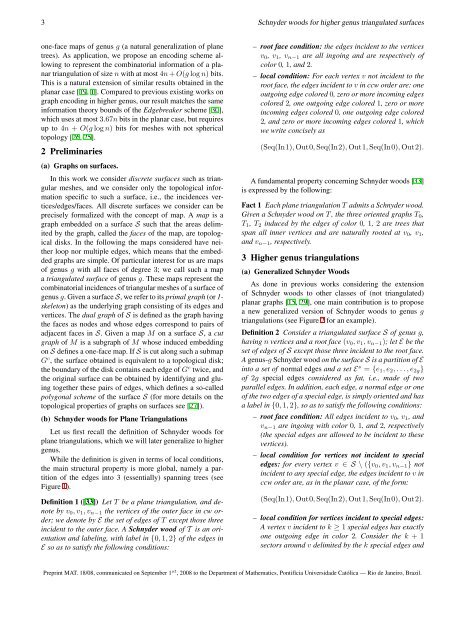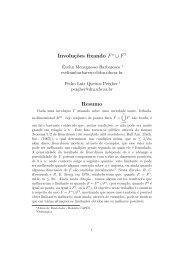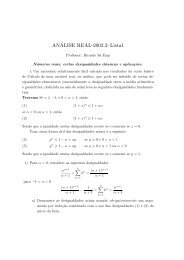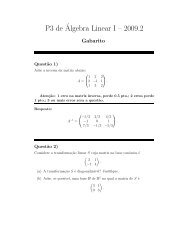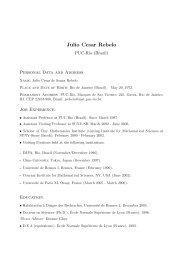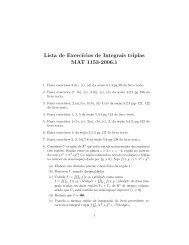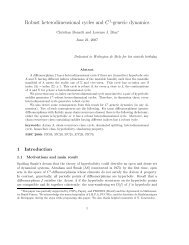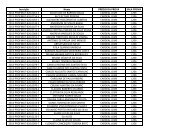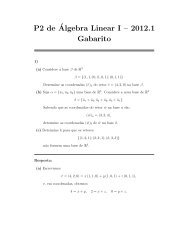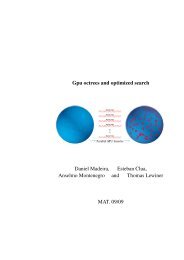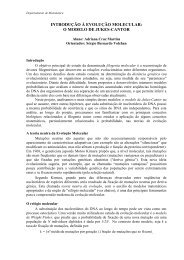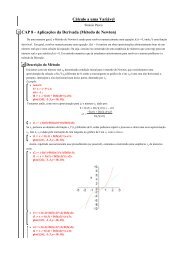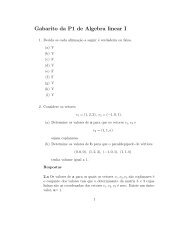Schnyder woods for higher genus triangulated surfaces with ...
Schnyder woods for higher genus triangulated surfaces with ...
Schnyder woods for higher genus triangulated surfaces with ...
Create successful ePaper yourself
Turn your PDF publications into a flip-book with our unique Google optimized e-Paper software.
3 <strong>Schnyder</strong> <strong>woods</strong> <strong>for</strong> <strong>higher</strong> <strong>genus</strong> <strong>triangulated</strong> <strong>surfaces</strong><br />
one-face maps of <strong>genus</strong> g (a natural generalization of plane<br />
trees). As application, we propose an encoding scheme allowing<br />
to represent the combinatorial in<strong>for</strong>mation of a planar<br />
triangulation of size n <strong>with</strong> at most 4n + O(g log n) bits.<br />
This is a natural extension of similar results obtained in the<br />
planar case [19, 1]. Compared to previous existing works on<br />
graph encoding in <strong>higher</strong> <strong>genus</strong>, our result matches the same<br />
in<strong>for</strong>mation theory bounds of the Edgebreaker scheme [30],<br />
which uses at most 3.67n bits in the planar case, but requires<br />
up to 4n + O(g log n) bits <strong>for</strong> meshes <strong>with</strong> not spherical<br />
topology [26, 25].<br />
2 Preliminaries<br />
– root face condition: the edges incident to the vertices<br />
v 0 , v 1 , v n−1 are all ingoing and are respectively of<br />
color 0, 1, and 2.<br />
– local condition: For each vertex v not incident to the<br />
root face, the edges incident to v in ccw order are: one<br />
outgoing edge colored 0, zero or more incoming edges<br />
colored 2, one outgoing edge colored 1, zero or more<br />
incoming edges colored 0, one outgoing edge colored<br />
2, and zero or more incoming edges colored 1, which<br />
we write concisely as<br />
(Seq(In1), Out0, Seq(In2), Out1, Seq(In0), Out2).<br />
(a) Graphs on <strong>surfaces</strong>.<br />
In this work we consider discrete <strong>surfaces</strong> such as triangular<br />
meshes, and we consider only the topological in<strong>for</strong>mation<br />
specific to such a surface, i.e., the incidences vertices/edges/faces.<br />
All discrete <strong>surfaces</strong> we consider can be<br />
precisely <strong>for</strong>malized <strong>with</strong> the concept of map. A map is a<br />
graph embedded on a surface S such that the areas delimited<br />
by the graph, called the faces of the map, are topological<br />
disks. In the following the maps considered have neither<br />
loop nor multiple edges, which means that the embedded<br />
graphs are simple. Of particular interest <strong>for</strong> us are maps<br />
of <strong>genus</strong> g <strong>with</strong> all faces of degree 3; we call such a map<br />
a <strong>triangulated</strong> surface of <strong>genus</strong> g. These maps represent the<br />
combinatorial incidences of triangular meshes of a surface of<br />
<strong>genus</strong> g. Given a surface S, we refer to its primal graph (or 1-<br />
skeleton) as the underlying graph consisting of its edges and<br />
vertices. The dual graph of S is defined as the graph having<br />
the faces as nodes and whose edges correspond to pairs of<br />
adjacent faces in S. Given a map M on a surface S, acut<br />
graph of M is a subgraph of M whose induced embedding<br />
on S defines a one-face map. If S is cut along such a submap<br />
G c , the surface obtained is equivalent to a topological disk;<br />
the boundary of the disk contains each edge of G c twice, and<br />
the original surface can be obtained by identifying and gluing<br />
together these pairs of edges, which defines a so-called<br />
polygonal scheme of the surface S (<strong>for</strong> more details on the<br />
topological properties of graphs on <strong>surfaces</strong> see [27]).<br />
(b) <strong>Schnyder</strong> <strong>woods</strong> <strong>for</strong> Plane Triangulations<br />
Let us first recall the definition of <strong>Schnyder</strong> <strong>woods</strong> <strong>for</strong><br />
plane triangulations, which we will later generalize to <strong>higher</strong><br />
<strong>genus</strong>.<br />
While the definition is given in terms of local conditions,<br />
the main structural property is more global, namely a partition<br />
of the edges into 3 (essentially) spanning trees (see<br />
Figure 1).<br />
Definition 1 ([33]) Let T be a plane triangulation, and denote<br />
by v 0 ,v 1 ,v n−1 the vertices of the outer face in cw order;<br />
we denote by E the set of edges of T except those three<br />
incident to the outer face. A <strong>Schnyder</strong> wood of T is an orientation<br />
and labeling, <strong>with</strong> label in {0, 1, 2} of the edges in<br />
E so as to satisfy the following conditions:<br />
A fundamental property concerning <strong>Schnyder</strong> <strong>woods</strong> [33]<br />
is expressed by the following:<br />
Fact 1 Each plane triangulation T admits a <strong>Schnyder</strong> wood.<br />
Given a <strong>Schnyder</strong> wood on T , the three oriented graphs T 0 ,<br />
T 1 , T 2 induced by the edges of color 0, 1, 2 are trees that<br />
span all inner vertices and are naturally rooted at v 0 , v 1 ,<br />
and v n−1 , respectively.<br />
3 Higher <strong>genus</strong> triangulations<br />
(a) Generalized <strong>Schnyder</strong> Woods<br />
As done in previous works considering the extension<br />
of <strong>Schnyder</strong> <strong>woods</strong> to other classes of (not <strong>triangulated</strong>)<br />
planar graphs [15, 29], one main contribution is to propose<br />
a new generalized version of <strong>Schnyder</strong> <strong>woods</strong> to <strong>genus</strong> g<br />
triangulations (see Figure 2 <strong>for</strong> an example).<br />
Definition 2 Consider a <strong>triangulated</strong> surface S of <strong>genus</strong> g,<br />
having n vertices and a root face (v 0 ,v 1 ,v n−1 ); let E be the<br />
set of edges of S except those three incident to the root face.<br />
A <strong>genus</strong>-g <strong>Schnyder</strong> wood on the surface S is a partition of E<br />
into a set of normal edges and a set E s = {e 1 ,e 2 , . . . , e 2g }<br />
of 2g special edges considered as fat, i.e., made of two<br />
parallel edges. In addition, each edge, a normal edge or one<br />
of the two edges of a special edge, is simply oriented and has<br />
a label in {0, 1, 2}, so as to satisfy the following conditions:<br />
– root face condition: All edges incident to v 0 , v 1 , and<br />
v n−1 are ingoing <strong>with</strong> color 0, 1, and 2, respectively<br />
(the special edges are allowed to be incident to these<br />
vertices).<br />
– local condition <strong>for</strong> vertices not incident to special<br />
edges: <strong>for</strong> every vertex v ∈ S \ ({v 0 ,v 1 ,v n−1 } not<br />
incident to any special edge, the edges incident to v in<br />
ccw order are, as in the planar case, of the <strong>for</strong>m:<br />
(Seq(In1), Out0, Seq(In2), Out1, Seq(In0), Out2).<br />
– local condition <strong>for</strong> vertices incident to special edges:<br />
A vertex v incident to k ≥ 1 special edges has exactly<br />
one outgoing edge in color 2. Consider the k +1<br />
sectors around v delimited by the k special edges and<br />
Preprint MAT. 18/08, communicated on September 1 st , 2008 to the Department of Mathematics, Pontifícia Universidade Católica — Rio de Janeiro, Brazil.


